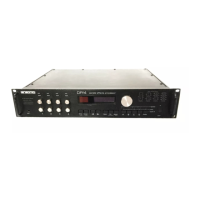Section 2 — Algorithms
76 ENSONIQ DP/4+ Reference Manual
PITCH SHIFTER
A pitch shifter allows you to change the pitch of a signal to any pitch desired within a range of
one octave in either direction. Pitch Shifter offers a 1 unit splicer type pitch shifter.
Try the different pitch shifters until you find the one that works best with your sound source, and
for your application. A “splicer type” of pitch shifter will drop or add small sections of the original
signal to the effect. Pitch Shifter uses only one unit, but does not incorporate zero crossing
detection. This pitch shifter is best used for a doubling effect. Splicer type pitch shifters are
popular because for low pitch shift ratios, splicing is infrequent. These pitch shifters can create
very interesting stereo fields by panning each of two pitch shifted voices selectively, and because of
the inherent time delay modulation of the algorithm. This pitch shifters takes the left channel input
as Voice 1, and the right channel input as voice 2.
Pitch Shifter Signal Routing
Right
Pan
L
Main
Outputs
Left
R
Vc 2 Pitch Shifter
Pan
Main
Outputs
Vc 1 Pitch Shifter
01 — Mix
02 — Volume
See the descriptions under the Mix and Volume Parameters, in the beginning of this section.
These algorithms sound best with a Mix of wet and dry. Try using a modulation controller for
the Mix parameter to bring in or fade out the pitch shifted signal.
03 — PitchShifter Vc 1 Semi Range: -12 to +12
Allows you to adjust the pitch of Voice 1 up to an octave above or below the original pitch in
semi-tones (half steps).
04 — PitchShifter Vc 1 Fine Range: -99 to +99
This parameter allows you to fine tune the pitch of Voice 1.
05 — PitchShifter Vc 1 Level Range: 00 to 99
Adjusts the volume of Voice 1. A setting of 00 would eliminate any audible pitch shift.

